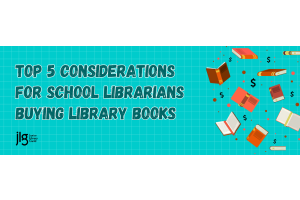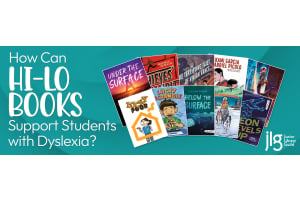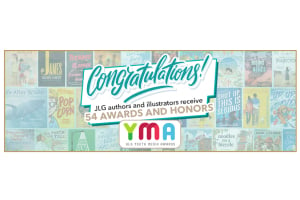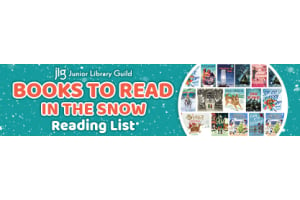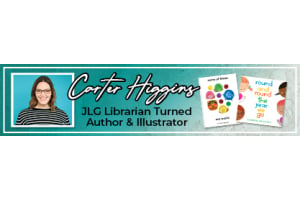Behind the Curtain: JLG Reveals the Selection Process


As you may know, JLG is recognized for selecting the best books and placing them in your hands for your readers. However, what many of us are unfamiliar with is the process behind picking these amazing, potentially award-winning titles. I sat down with Liz Gavril, executive editor at JLG, to learn more about the secretive world of picking books.
KH: Liz, what does a typical day look like for a JLG editorial staff member?
LG: Reading! There’s always reading, which probably does not come as a big surprise. We get a huge number of submissions—5,000+ per year. The majority of the editorial staff’s time is spent reading and evaluating books for our many categories. We share an office with two of our sister companies, School Library Journal and Library Journal, and those employees are often amazed at how quiet it is in our part of the office. We’re also always making decisions about what books to take, and there’s constant logging in and tracking the materials we receive.
KH: WOW, more than 5,000 a year! That is a lot of reading. Can you explain a bit about the selection process?
LG: It’s a comparative and collaborative process. We have two lists per year, as do most publishing companies. We are reading as many books as possible, from as many different publishers as possible, for each six-month span. And we are choosing the ones for every category that we think stand out during that particular time period. Sometimes a book will work in multiple categories, so there are additional steps to decide where the book fits best. This season, for example, we had a book—Between the Lines: How Ernie Barnes Went from the Football Field to the Art Gallery—that would fit equally well in the elementary arts and sports categories (a crossover possibility we rarely see!).
We consider only frontlist titles and see pre-publication materials; we make our decisions in time to run on with the publishers’ first print runs. So we are constantly juggling individual publishers’ print deadlines with our internal deadlines.
KH: Does your staff secretly have a crystal ball lying around? I ask because Wolf in the Snow, the recent Caldecott Medal winner, was picked in 2016! How did you know this would be a big hit?
LG: We get asked that a lot. And though I sometimes think it would be fun to have a crystal ball, alas, we do not. It is the result of hard work, putting in the time to evaluate all the submissions we receive. And of course, it is gratifying when something we have chosen goes on to great acclaim.
In the case of Wolf in the Snow, we received materials for the book in June 2016 and selected it that month; the book was published in January of 2017. This year the ALA Midwinter conference was later than usual, so the book won the Caldecott more than a year after it was published. When we saw materials, we immediately thought the nearly wordless book stood out for its visual storytelling, striking perspectives, and expansive double-page horizontal spreads. As a reader, you feel like you’re in the middle of that storm, too, lost with the girl and the wolves. And those wolves! Those first couple of spreads that show the wolves are so arresting. It was interesting to see Matthew Cordell, who usually works in a more comic style, depict them realistically. We were delighted that the Caldecott committee recognized it. Personally I have been a fan of Cordell’s work for quite a while—Another Brother is a particular favorite.
Incidentally, we were equally excited that Erin Entrada Kelly won this year’s Newbery for Hello, Universe. We took her debut novel, Blackbird Fly, in 2015, and every one of her novels since (including You Go First, which is publishing this spring). It’s been fun to follow the trajectory of her career as an author.
KH: What qualities do you look for in a book that will become a JLG Gold Standard selection?
LG: For some of our categories, we are limited to certain books that fit a specific topic or format. So we need books that take place in urban environments for our city categories, for example, or a certain type of book that is suited to emergent readers or a story that would make a great read-aloud. We don’t control what is published, obviously, so sometimes these categories are harder to fill than others. Sometimes we actually have to go hunting for more options, or we might work with publishers to offer a hardcover or library format if they didn’t already plan to. I always find it interesting that some spans, specific categories may be difficult to fill, and then six months—or a year or two years later—it will change and we will have a wealth of choices. Sometimes we wish we had more spaces in a particular category because there are so many stand-out options.
We are always keeping our member librarians in mind—looking for books that will serve their libraries and patrons well. And most of all, we are looking for books that children will enjoy, that they will want to read again and again. We always look for stories that are well told. We’re looking for something that is memorable, something that is unusual, something that is strikingly illustrated, something that makes us laugh (or cry), something that hasn’t been done a million times before—or if it has, that there’s something remarkable about it. There are so many books published for children, and we are looking for the ones that truly stand out from the crowd.
KH: What happens when an editor starts a book and after the first couple chapters, does not like it? Do they stop reading or continue on and give it a chance?
LG: We have a procedure to prioritize our reading: we read all longer submissions for a brief period to get a sense of what the book is about and how interested we are. We concentrate on the most promising ones, followed by those that are initially less promising. It is important that books for kids start out strong to capture readers’ attention, but sometimes a book with a very unusual premise or a powerful ending can win us over.
In terms of when someone stops reading a particular book, we each have our own way of working, and we read for different categories. Some readers are quicker to put something aside initially in order to go on to something else, and they may come back to it later. I personally tend to keep reading initially.
KH: Do you have a favorite book you have picked over the years? Or any book that stands out that you a proud of selecting?
LG: That is always such a hard question to answer. There are certainly authors and illustrators whose work I admire, and I’m always excited when we receive their latest projects. And I love discovering debut authors and illustrators. Plus, it’s a privilege to see all these amazing books before they are available out in the world. But I think most of us who work in this field have a tough time choosing a favorite book. There are so many noteworthy books being published. I have worked at JLG for over ten years now, so I have many, many favorites. We have even decided to feature some of our many beloved titles from the current list in a series of webcasts.




